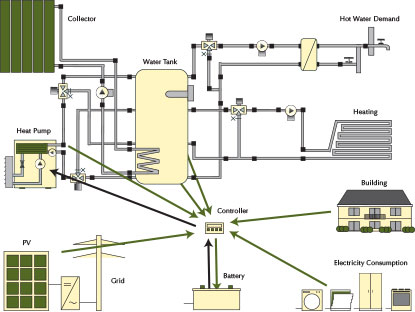Photovoltaics is process by which semiconductors produce electricity generated by exposure to the radiation in sunlight. The word is not well known to most people’s vocabulary, but it may one day be as common as turning on a hot water faucet or adjusting a thermostat. This year’s EU Photovoltaic Solar Energy Conference (PVSEC), which was held in Paris at the beginning of October, saw the presentation of the results from a number of current research projects on photovoltaics (PV) self-consumption optimization.
These results are the product of a collaborative research effort carried out jointly by Vela Solaris and the Swiss Federal University of Technology in Zurich (ETH Zurich) with the funding support of the Federal Office for Energy and Swisselectric Research. As PV technology is more widely used in heat pump systems, greater focus will be placed on control and efficiency.

ONE SOLUTION, LARGE OR SMALL
Vela Solaris AG develops and markets worldwide its Polysun design software, an innovative tool used by engineers and installers alike to design and optimize decentralized energy systems including solar thermal, photovoltaic, heat pump, and geothermal systems. The product range is rounded off by software versions tailor-made to suit the needs of large customers as well as by an online solution.
With Polysun 6.2, users have access to the latest developments in the renewable energy sector, resulting from a variety of research projects. So, for example, battery life is also taken into account when it comes to the dimensioning of an electric storage system.
SELF-CONSUMPTION OPTIMIZATION
Only a few months after their first release, the PVSEC Conference results are now being made available to a wide audience of users with the Polysun Update 6.2. Simulations show the limits as well as the benefits of these now widely debated storage solutions consisting of a combination of thermal and battery storage. A prerequisite to ensure that reliable results are obtained is the use of programmable controllers (available in Polysun from Version 6.1) as well as realistic profiles (a new feature in the 6.2 version: profiles with 15-minute time-steps). According to the type of solar system, the type of building and consumption profile, a heat pump with intelligent controller or a battery are proposed as the optimal solution.

THE LIFE OF BATTERIES DEPENDS ON THEIR USE
Further cooperation with the ETH Zurich Power Systems Laboratory resulted in research being conducted on the life of batteries. The latest version of Polysun supports the dimensioning of electrical storage systems with a new battery model and does so by recording the “state of health” (SOH) of batteries during the simulation. The deeper and more frequently a battery is discharged, the lower the parameter that indicates its remaining life will drop.
Thus, the following optimization issue arises for the dimensioning: the purchase of a small battery will prove more affordable; however, it will be severely challenged going through repeated deep discharge cycles and will need to be replaced sooner. The additional costs associated with the purchase of a larger battery prove worthwhile in view of its longer duration within a given time span. If the battery is too large, the initial investment will no longer be justified. ■
_________________________________________________________________________
ABOUT THE AUTHOR
Lars Kunath is the design engineer for solarthermal, photovoltaic, and heat pump systems at Vela Solaris. He can be reached at 415. 202.5275 or usa@velasolaris.com. For more details on Polysun and Vela Solaris, visit www.velasolaris.com.
_________________________________________________________________________
MODERN PUMPING TODAY, December 2013
Did you enjoy this article?
Subscribe to the FREE Digital Edition of Modern Pumping Today Magazine!
![]()


